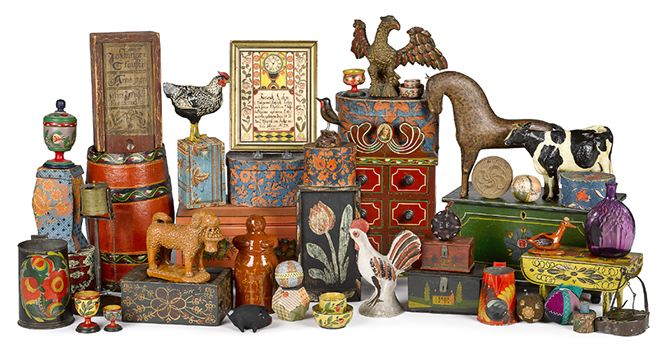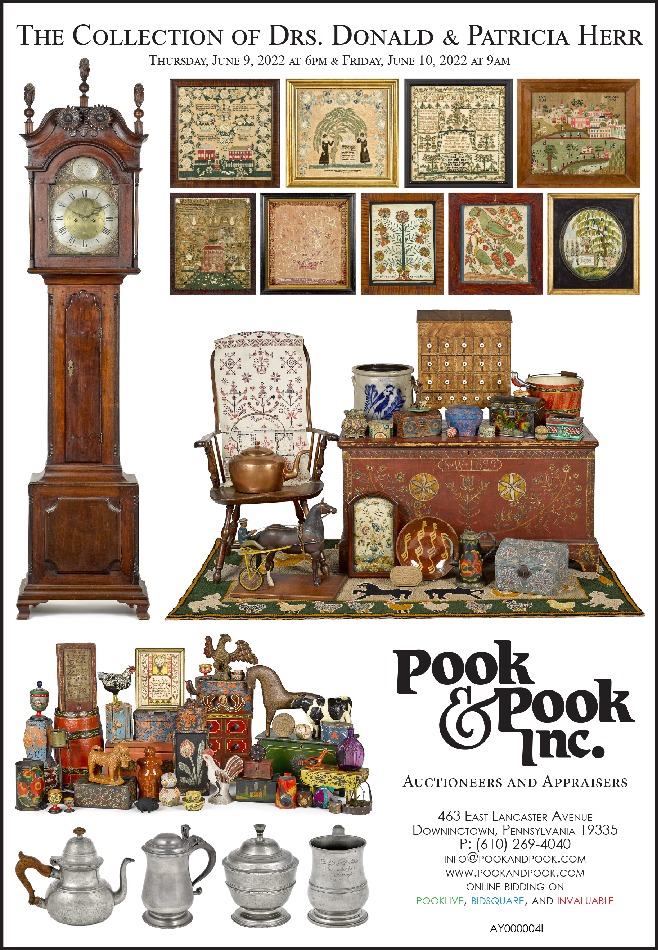Events
Home / Events

Pook & Pook – The Collection of Drs. Donald & Patricia Herr
Thu Jun 09, 2022 - Fri Jun 10, 2022
463 East Lancaster Ave. - Downingtown, PennsyLvania 19335
Pook & Pook – The Collection of Drs. Donald & Patricia Herr
June 9 at 6 pm & June 10 at 9 am
463 East Lancaster Ave. Downingtown, PennsyLvania 19335
www.PookandPook.com
info@PookandPook.com
610-269-4040
DOWNINGTOWN, PENN. — Collectors of Pennsylvania German folk art for six decades, Donald and Patricia Herr became true connoisseurs, retaining only the best examples of an artist’s work, the best of a form and the rarest and most highly sought-after examples. Their collection exemplifies their love of Pennsylvania German decorative arts, and it comes to auction at Pook & Pook on June 9 and 10.
Researching and documenting their collection, the Herrs may have applied scientific method to antiques. They published studies and research papers on a wide range of Pennsylvania German subjects. They recorded their observations, made comparative studies and researched provenance and the progress of objects, artisans and families through time. Throughout the collection, common family names crop up on diverse items. Alongside the colorful painted wooden creations of Joseph Lehn, one finds his copybook, dated 1843, and a fraktur by his son Henrich Lehn for his grandson, Joseph, born 1829. The Herr name is found on diverse objects, with a Herr family coverlet, a Grandmother Herr quilt, an 1828 David Herr watercolor fraktur of birds and Herr family birth and baptismal fraktur. The Herrs’ research led to new discoveries, such as when Dr Herr and Dr Don Yoder collaborated to uncover the identity of the “Sussel Unicorn Artist.”
Schoolmaster Christian Beschler (circa 1800) created only ten known works, eight of which are taufscheine. Two of these rarities are a birth and baptismal certificate for Jacob Jaekle, dated 1796; and one for Magdalena Fuchs (b 1801). Both are profusely decorated with compass stars, hearts, unicorn and parrots amid tulips, flower and vines. Other works in this group include a Johann Heinrich Otto (southeastern Pennsylvania, active 1762-1797) watercolor fraktur of a parrot and bird perched on stylized flowers, and works by Georg Frederich Speyer, Henrich Dulheuer, Samuel Bentz, John Zinck, Jacob Andreas and Christian Strenge.
Patricia Herr’s collection documents early schools of needlework. Three works from the Marsh School (Philadelphia, 1723-1795) include one by Ann Marsh herself, circa 1730, a vibrant work with an urn of flowers with insect and bird, resting on a rolling lawn with sheep and a running dog, retaining the original tombstone arched walnut frame. Ann, alongside her mother Elizabeth, taught the daughters of elite Philadelphia Quaker families the art of ornamental embroidery. Marsh works are rare and, according to Betty Ring, are the earliest identifiable group of Philadelphia needleworks. Seven works from the Lititz Moravian School include a silk-on-silk memorial embroidered sampler attributed to Mary Ann or Rebecca Catherine Peterson, circa 1833, in memory of their father. Another highlight is the earliest known Lititz silk mourning embroidery, circa 1805, attributed to Sara Pim, “Columbia Mourns for Washington.” From the school of Mrs Catharine Welshans Buchanan, a scarce Marietta, Lancaster County silk-on-linen memorial needlework dated 1827 is inscribed “Eliz Groshs work made in Marietta in Mrs Buchnans School in the year of our Lord 1811.”
The most coveted makers of wooden boxes hold a special place in the collection. A John Palm Boyer (1833-1901), Brickerville, Lancaster County, painted pine seed chest, circa 1860, retaining its original faux grain decoration, the case with a fall front lid over 15 drawers, with a lower row of seven small drawers resting on bootjack feet. Of 23 Joseph Lehn-related pieces featured, one is a painted poplar seed chest with decoupage decorated crest and sides and a brick red ground. There are two Nineteenth Century Lancaster Weber dresser boxes, one red ground and one blue, each with vibrant floral decoration, houses and trees.
Pennsylvania German carvings include a Wilhelm Schimmel spread-winged eagle with original polychrome surface and unusual gilt body, which sits alongside two spirited Peter Brubaker (Lancaster County, 1816-1898) carved and painted horses, one chestnut and one dapple grey. Engaging carved figural groups by George G. Wolfskill (Fivepointville, Lancaster County, 1872-1940) include an entire foxhunt.
Metal works by artisans John Long (Sporting Hill, Rapho Township, Lancaster, 1787-1856) and Peter Derr (Tulpenhocken Township, Berks County, 1793-1868) exhibit the best qualities of their type. A rare John Long wrought iron and brass fat lamp is inscribed “Fanny M. Erisman Manufactured By John Long.”
Pewter is the crown jewel in the Herr collection, abounding in rare items. A Lancaster, Penn., pewter flagon, circa 1770, bears the touch of Johann Christoph Heyne (1715-1781). Another work by Heyne, a circa 1770 canteen, was a memorable find at a Carlisle flea market. One gifted pewterer stands above the rest. William Will (1742-1798), patriot, statesman and pewterer, was the son of John Will, who arrived in America in 1752. The Herrs collected the works of both father and son. Nine objects by William Will include sugar bowls, mugs, a tulip tankard, a drum teapot and the jewel of the collection, a coffee pot, circa 1780. While few examples of this form exist, it has remained one of the most iconic pieces of American pewter. Standing 16 inches in height, its clean neoclassical lines and symmetry lend it visual impact. Of the works attributed to and bearing the touch of John Will (1696-circa 1774), a flagon and chalice, circa 1760, has been traced to the Round Top Lutheran Church, Bethel, N.Y.
Pook & Pook is at 463 East Lancaster Avenue. For information, www.pookandpook.com or 610-269-4040.

Antiques and The Arts Weekly is the nation’s leading weekly publication on the antiques and the arts trade, and is available both in print and online.
Each issue average between 100-200 pages and includes reporting on auctions, antiques shows and the arts while providing a platform for both buying and selling.
We have been providing breaking news and important information on the world of antiques and the arts since Publisher R. Scudder Smith started Antiques and The Arts Weekly back in 1963.
Contact
LOCATED AT:
5 Church Hill Road / Newtown, CT 06470
HOURS:
Mon - Fri / 8:00 am - 5:01 pm
PHONE:
(203) 426-8036

